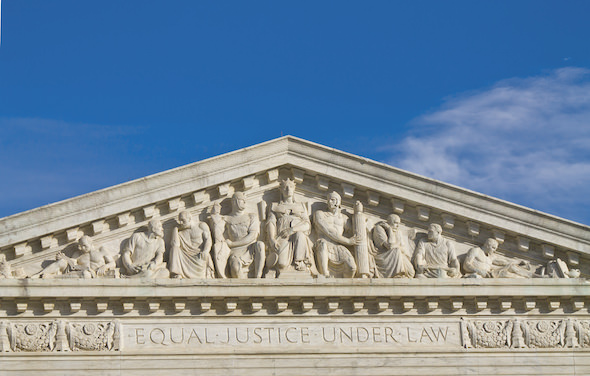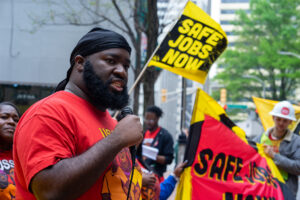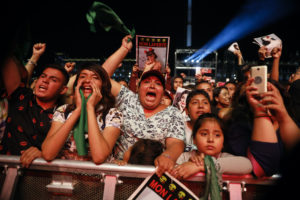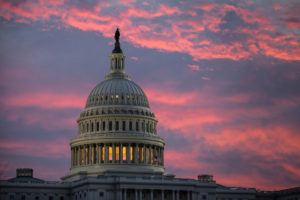Recent Rulings Expose Supreme Court’s Anti-Worker Bias
There is no question that the Roberts court has made the task of union organizing more difficult. And if Brett Kavanaugh's nomination is confirmed, there is little doubt that difficulties will intensify. Shutterstock
Shutterstock
Toward the end of the oral argument in a pivotal labor case before the U.S. Supreme Court last February, Justice Sonia Sotomayor made a comment that cut to the heart of the matter.
“You’re basically arguing, do away with unions,” Sotomayor said.
The case, Janus v. American Federation of State, County, and Municipal Employees, Council 31, concerns the right of public-employee unions to collect fees from nonunion workers. The plaintiff, Mark Janus, is an Illinois state public employee who refuses to join AFSCME, which acts as the bargaining agent for rank-and-file employees in his department, and objects to having “fair-share” fees deducted from his monthly paychecks.
Sotomayor’s remark was directed to Janus’s attorney William Messenger. It echoed the concerns of progressive activists across the country, who say the case poses an existential threat to public-sector unions, which rely on fair-share fees from nonmembers to defray the costs of collective bargaining and contract administration.
Messenger, a staff lawyer for the National Right to Work Legal Defense Foundation and member of the conservative Federalist Society, hemmed a bit at the justice’s bluntness, but he stuck to the central position he had advanced in his argument and briefs: that the case was about the First Amendment. He insisted that Americans have not only an affirmative right to speak but also a passive right not to be compelled to speak. And making nonunion public employees pay fees to a union, he and others contend, amounts to compelled speech.
In late June, the Supreme Court accepted this reasoning and sided with Janus, ruling 5-4 that public-employee unions may not collect fair-share fees. Without these revenues, many unions believe their coffers will dry up, and their membership rolls will shrivel.
In other words, Sotomayor grasped the essence of the issue.
As of the date the decision was handed down, twenty-eight states had adopted right-to-work laws prohibiting fair-share deductions. The remaining twenty-two and the District of Columbia permitted them for some five million state and local government employees. In effect, the decision has turned the country’s entire public sector into one giant right-to-work jurisdiction.
The majority opinion in the Janus ruling was written by Justice Samuel Alito, with Trump appointee Neil Gorsuch, who replaced the late Antonin Scalia on the bench last year, siding with the majority. Also in the majority were Chief Justice John Roberts and Justices Clarence Thomas and Anthony Kennedy. All were appointed by Republican Presidents.
Alito concluded that even though mandatory fair-share fees cannot be used for political purposes, they are nonetheless a form of coercion. “It is hard to estimate how many billions of dollars have been taken from nonmembers and transferred to public-sector unions in violation of the First Amendment,” Alito wrote. “Those unconstitutional exactions cannot be allowed to continue indefinitely.”
The ruling reversed a 1977 Supreme Court precedent—Abood v. Detroit Board of Education—that upheld the fair-share system against a First Amendment challenge.
Yet the outcome in Janus was entirely expected, given the animus toward unions expressed by the Roberts Court in recent years (see sidebar). In two prior cases—Knox v. SEIU in 2012 and Harris v. Quinn in 2014—the court found that the payment of union dues by public employees is a form of political speech subject to the constraints of the First Amendment.
In 2016, after Scalia’s death, the Supreme Court deadlocked 4-4 in another appeal, Friedrichs v. California Teachers Association, involving fair-share assessments. With Janus, the issue has now been laid to rest. Henceforth, in the estimation of the nation’s highest judicial body, all spending by public-sector unions will be considered political.
Even before the Janus decision, no one could be forced to join a union. In non-right-to-work jurisdictions, they could simply be assessed a fee designed to equitably distribute the cost of union activities among those who benefit through higher wages, pensions, health insurance, and assistance with workplace grievances and disciplinary hearings.
While the Janus ruling doesn’t affect private-sector unions, it will have a potentially devastating impact in the public sphere by encouraging more government employees to become “free riders” in terms of union representation. In most jurisdictions, even in right-to-work states, unions have a duty to act as the exclusive representative of all employees within a bargaining unit, members and nonmembers alike. It takes money to do that, and without fair-share fees, public-employee unions will be hard-pressed to meet their obligations.
“Within three to five years, we’ll see significant membership declines,” predicts Robert Bruno, who directs the Labor Education Program for the School of Labor and Employment Relations at the University of Illinois, Urbana-Champaign. Together with Frank Manzo, Bruno authored a detailed study for the Illinois Economic Policy Institute in 2017 about the likely impact of the Janus case. They predicted that a right-to-work win would:
- Reduce union membership among state and local public employees by 8.2 percentage points, or 726,000 union members.
- Decrease public-sector unionization by 189,000 members in California, 136,000 members in New York, and 49,000 members in Illinois.
- Reduce the union membership rate among teachers by 4.8 percentage points—a loss of 88,000 members for teachers unions.
- Disproportionately impact African American workers, who are more likely to work in state and local government and be union members.
“Right-to-work laws,” Bruno says, “also have a depressing effect on wages.” In another research paper published before the Janus decision, he and Manzo reported that workers in Indiana, Michigan, and Wisconsin, all of which have passed right-to-work laws, earned 8 percent less per hour in 2016 than their counterparts in the adjacent non-right-to-work states of Illinois, Minnesota, and Ohio.
Other researchers have made similar findings. According to a survey conducted by the Century Foundation, unionized teachers made an average of 24.7 percent per hour more than their nonunion colleagues. Nationwide, median earnings for two-income, nonunion families are $400 a week less than for union families. The plain fact is that unions are good for workers.
The National Right to Work Legal Defense Foundation, which represented Mark Janus along with the rightwing Liberty Justice Center, is an arm of the National Right to Work Committee, which has long set its sights on crippling trade unions. It was founded in 1955 by former New Jersey Congressman Fred Hartley, co-sponsor of the anti-union Taft-Hartley Act, and included Birch Society stalwart Fred Koch, the father of David and Charles.
In 2012, the Kochs’ Freedom Partners group funneled $1 million to the committee. Other financial backers include the Walton Family Foundation (of Walmart), the Coors family’s Castle Rock Foundation, Wisconsin’s Bradley Foundation, the John M. Olin Foundation, and the Searle Freedom Trust. Since the 1990s, The Guardian reported, the Bradley Foundation has donated $30.5 million to twenty-four organizations that have supported lawsuits against public unions.
It’s easy to see why the political right is focused on public-employee unions. In the private sector, the unionization rate has dwindled to 6.5 percent. The public sector, by contrast, boasts a unionization rate of 34.4 percent. Not coincidentally, unionized workers are more likely to vote Democratic. A Brookings Institution analysis published earlier this year found that from 1980 to 2016, right-to-work laws have decreased the Democratic presidential vote share by 3.5 percent.
And while fair-share fees cannot be used for political purposes, union dues can be channeled through political action committees and super PACs. As their membership ranks have grown, public-employee unions have become a key source of funding for Democratic office seekers. During the 2016 election cycle, AFSCME alone donated nearly $16 million to pro-Democratic super PACs, party committees, and candidates.
From a legal perspective, the Janus decision is little more than a smokescreen to obscure the right wing’s politically motivated attacks. “The fact is that the Janus majority opinion is not about expanding the speech rights of public employees at all,” Alice O’Brien, general counsel for the National Education Association, charged in a column posted by the SCOTUSblog.com website. “It is about five justices constitutionalizing their disdain for the right of working people to come together to speak with a unified and strong voice.”
Julius Getman, an expert in labor law who teaches at the University of Texas at Austin School of Law, expounds on this theme in an interview with The Progressive.
“Nothing about the fair-share system prevented Mark Janus or any other public employee from speaking out on any issue,” notes Getman. “To say that it did is pure bullshit. There are so many situations where people are legally required to pay money to institutions they may not like as a condition of employment, such as the bar dues paid by lawyers.”
Getman, the author of The Supreme Court on Unions: Why Labor Law Is Failing American Workers, published in 2016 by Cornell University Press, says labor unions “have always had a difficult time in the courts, dealing with hostile judges and anti-union doctrines. But this is a particularly bad time for the simple reason that the Supreme Court under John Roberts has no sympathy for working people. To the extent the current court has a consistent ideology, it is support for the market.”
In terms of broad constitutional theory, Getman believes we’re witnessing a return to what scholars call “the Lochner era”—so named after the 1905 case of Lochner v. New York.
Like Janus, Lochner was decided by a 5-4 vote. In it, the Supreme Court overturned New York’s Bakeshop Act of 1895, which was designed to protect bakery employees by limiting their maximum working hours to ten per day and sixty per week. The court said the law violated the due process clause by interfering with workers’ liberty to contract.
In subsequent decades, guided by similar free market principles, the court also upheld “yellow dog” labor contracts allowing employers to refuse to hire union members; overturned the federal child labor act; nixed legislation setting minimum wages for women and children in Washington, D.C.; and invalidated a law requiring that rail workers receive pensions.
Getman says the Roberts Court’s “return to Lochner was even more evident” in its May ruling in Epic Systems Corp. v. Lewis. That case involved a Wisconsin-based health care software company that had notified its employees that they needed to resolve any wage and hour claims through individual arbitration rather than collective or class actions.
Jacob Lewis, then a technical writer with Epic, filed a federal complaint in 2015 on behalf of himself and other writers whom, he alleged, were unlawfully denied overtime pay under the Fair Labor Standards Act. Lewis argued that the company’s arbitration policy violated the part of the National Labor Relations Act that safeguards the right of employees to engage in concerted activities for mutual aid and protection.
Lewis won at both the trial level and in the Seventh Circuit Court of Appeals. But his triumph proved short-lived. In January 2017, the Supreme Court agreed to hear Epic’s appeal, consolidating it with two other wage-and-hour disputes. The court’s decision in Epic, once again cleaved 5-4 along ideological lines, upheld the arbitration provisions and class-action waivers in all three cases. The majority opinion was written by Gorsuch. While the ruling’s scope is unclear, some observers believe it will also apply to discrimination and sexual harassment claims.
Getman believes the Epic decision will hurt even more people than Janus because it applies to all workers, union and nonunion, as well as consumers, who are routinely subject to fine-print arbitration clauses governing everything from cell-phone services to banking transactions.
So is the Roberts Court worse for labor and workers than its Gilded Age predecessors? “I think it’s more a matter of continuity,” Getman says. “If you go back to the early days of the labor movement, you see many [anti-labor] ideas that are being replicated today.”
What can labor do to fight back? Getman says it’s vital for the Democratic Party to restore its ties to organized labor: “The Democrats have to realize just how much of their support and their base comes from unions. What we saw and heard during the [2016] presidential campaign was just platitudes.”
Bruno, meanwhile, says unions can press for statutory changes to relieve them from their costly duties of representing nonunion workers in grievances with management. New York State passed such legislation in March. More important, Bruno says, unions can return to “good old-fashioned bargaining for the common good,” reaching out to broader communities to help build and sustain healthy families and better neighborhoods.
Bruno sees that happening in places like Chicago, where the local teachers’ union has demanded that inner-city schools be kept open and classroom sizes reduced. He’s also encouraged by the teacher strikes this spring in red states like West Virginia, Arizona, and Oklahoma.
There is no question that the Roberts Court has made the task of union organizing more difficult. And going forward, if Trump’s latest Supreme Court nominee—Brett Kavanaugh of the D.C. Circuit Court of Appeals—is confirmed, there is little doubt the difficulties will intensify.
Sidebar: The Roberts Court’s Hostility to Labor
Since John Roberts was appointed Chief Justice of the Supreme Court in 2005, the court has been hard on labor unions and the rights of working people. Here are some examples:
Ledbetter v. Goodyear Tire and Rubber Co. (2007): Set a time limit of 180 days for bringing civil rights lawsuits for sex discrimination complaints in federal court. The ruling was effectively repealed by the 2009 Fair Pay Act.
Davenport v. Washington Education Association (2007): Allowed states to require unions to obtain affirmative consent before spending nonmember public employees’ fees on political activities, rather than refunding fees retroactively to objecting non-members on request.
14 Penn Plaza LLC v. Pyett (2009): Upheld a provision in a collective bargaining agreement that required union members to arbitrate age-discrimination claims.
Wal-Mart v. Dukes (2011): Declined to certify a class-action, pay-discrimination case brought on behalf of 1.5 million female employees, establishing a standard that makes it more difficult to bring class actions over wages in federal court.
Burwell v. Hobby Lobby Stores (2014): Declared that privately held for-profit corporations are “persons” engaged in the “exercise of religion” and may deny health insurance coverage for contraception to female employees.
University of Texas Southwestern Medical Center v. Nassar (2013): Heightened the burden of proof plaintiffs must meet in individual race-based workplace discrimination suits.
Vance v. Ball State University (2013): Redefined the concept of “supervisor” under the Civil Rights Act to relieve a corporate employer from liability in hostile work environment cases.
Knox v. SEIU (2012) and Harris v. Quinn (2014): Limited fair-share fees in the public sector but stopped short of declaring them unconstitutional.
Integrity Staffing Solutions, Inc. v. Busk (2014): Held that the time spent by warehouse workers waiting to check out for the day is not compensable under the Fair Labor Standards Act.
Epic Systems Corp. v. Lewis (2018): Affirmed mandatory arbitration agreements providing for individualized proceedings.
Janus v. American Federation of State, County, and Municipal Employees, Council 31 (2018): Overturned an earlier ruling to declare that extracting fees from nonconsenting public-sector employees violates the First Amendment.
Your support matters…Independent journalism is under threat and overshadowed by heavily funded mainstream media.
You can help level the playing field. Become a member.
Your tax-deductible contribution keeps us digging beneath the headlines to give you thought-provoking, investigative reporting and analysis that unearths what's really happening- without compromise.
Give today to support our courageous, independent journalists.






You need to be a supporter to comment.
There are currently no responses to this article.
Be the first to respond.